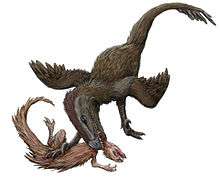Echinodon
| Echinodon Temporal range: Early Cretaceous, 140 Ma | |
|---|---|
 | |
| Specimen NHMUK 48215b | |
| Scientific classification | |
| Kingdom: | Animalia |
| Phylum: | Chordata |
| Clade: | Dinosauria |
| Order: | †Ornithischia |
| Family: | †Heterodontosauridae |
| Genus: | †Echinodon Owen, 1861 |
| Species | |
Echinodon (pronounced eh-KY-no-don) meaning "hedgehog tooth" in reference to the spines on its teeth (Greek εχινος, echinos = hedgehog + όδους, odous = tooth), occasionally known as Saurechinodon, is a genus of small European dinosaur of the early Cretaceous Period (Berriasian age), 140 million years ago.
Discovery and species

The type specimen was discovered by Samuel Beckles in the Purbeck Beds near Swanage, England. A bipedal herbivore, it was around 60 centimetres (2 ft) long. Unlike most ornithischians, Echinodon had one or two caniniform teeth in each maxilla.[1]
The only species is E. becklesii, named in 1861 by Richard Owen, who mistook it for a lizard. Remains of an Echinodon-like animal were found in stratigraphic zone 4 of the Morrison Formation.[2] These are now named Fruitadens.[3]
Classification
Echinodon has at times been considered a basal thyreophoran, mainly due to the erroneous association of turtle limb osteoderms with its remains. Paul Sereno's reclassification to Heterodontosauridae in 1991 remains somewhat controversial. David B. Norman and Paul M. Barrett redescribed Echinodon in 2002 and supported the heterodontosaurid classification, though using somewhat different evidence than Sereno.
The cladogram below follows the analysis by Butler et al., 2011:[4]
| Heterodontosauridae |
| ||||||||||||||||||||||||||||||
References
- ↑ Palmer, D., ed. (1999). The Marshall Illustrated Encyclopedia of Dinosaurs and Prehistoric Animals. London: Marshall Editions. p. 135. ISBN 1-84028-152-9.
- ↑ Foster, J. (2007). "Appendix." Jurassic West: The Dinosaurs of the Morrison Formation and Their World. Indiana University Press. pp. 327-329.
- ↑ Butler, Richard J.; Galton, Peter M.; Porro, Laura B.; Chiappe, Luis M.; Henderson, D. M.; Erickson, Gregory M. (2009). "Lower limits of ornithischian dinosaur body size inferred from a new Upper Jurassic heterodontosaurid from North America" (PDF). Proceedings of the Royal Society B. 277 (1680): 375–81. PMC 2842649
 . PMID 19846460. doi:10.1098/rspb.2009.1494.
. PMID 19846460. doi:10.1098/rspb.2009.1494. - ↑ Richard J. Butler, Jin Liyong, Chen Jun, Pascal Godefroit (2011). "The postcranial osteology and phylogenetic position of the small ornithischian dinosaur Changchunsaurus parvus from the Quantou Formation (Cretaceous: Aptian–Cenomanian) of Jilin Province, north-eastern China". Palaeontology. 54 (3): 667–683. doi:10.1111/j.1475-4983.2011.01046.x.
- Norman D, Barrett P (2002). "Ornithischian dinosaurs from the Lower Cretaceous (Berriasian) of England". Special Papers in Palaeontology. 68: 161–189.




